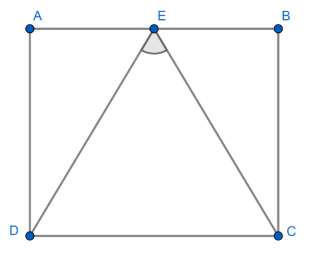
Let ABCD be a parallelogram and let E be the mid point of side AB. If EC is perpendicular to ED, then
(a) \[ED=EC\]
(b) \[EB=BC\]
(c) \[EA=ED\]
(d) \[EC+ED=2BC\]
Answer
609.3k+ views
Hint: Consider the properties of parallelogram (we know that $AB\parallel CD\text{ and }AD\parallel BC$ for a parallelogram) to solve the question.
From the figure, consider the parallelogram ABCD.

From the properties of parallelogram, we know that $AB\parallel CD\text{ and }AD\parallel BC$
i.e., $AB$ is parallel to $CD$ and
$AD$ is parallel to $BC$
Which can also be considered as sides $AB$ and$DC$ are equal
$AB=DC$
Similarly $AD=BC$
i.e., Both pairs of opposite sides are parallel and they are congruent.
From the figure, it's clear that E is the midpoint of side \[AB.\]
i.e. $AE=EB$
It’s also given that $EC$ is perpendicular to $ED$ and they form an angle of $90{}^\circ $.
i.e., $\angle DEC=90{}^\circ $
In the case of parallelogram $ABCD,\text{ }\angle A=\angle C\text{ and }\angle B=\angle D$ .
From the figure we can find that $ED\ne EC.$ i.e., they are not of the same length.
Which means both $ED\text{ and }EC$are greater than the length $DC$
$\Rightarrow ED>DC\text{ and E}C>DC$
Now adding them together
\[\frac{\begin{align}
& ED>DC \\
& ED>DC \\
\end{align}}{ED+EC>2DC}\]
Let us consider that $BC$ is greater than $DC$
$\therefore $ Equation becomes $\Rightarrow ED+EC=2BC.$
So option D is correct.
Note: Remember the properties of parallelogram, with which we have to solve this equation.
As $EC\bot ED,$ students may miscalculate that $EC=ED$ which states that option A is wrong.
From the figure, $EA\ne ED$ i.e., $EA$ is shorter than the length of $ED,$ So option C is wrong.
From the figure, consider the parallelogram ABCD.

From the properties of parallelogram, we know that $AB\parallel CD\text{ and }AD\parallel BC$
i.e., $AB$ is parallel to $CD$ and
$AD$ is parallel to $BC$
Which can also be considered as sides $AB$ and$DC$ are equal
$AB=DC$
Similarly $AD=BC$
i.e., Both pairs of opposite sides are parallel and they are congruent.
From the figure, it's clear that E is the midpoint of side \[AB.\]
i.e. $AE=EB$
It’s also given that $EC$ is perpendicular to $ED$ and they form an angle of $90{}^\circ $.
i.e., $\angle DEC=90{}^\circ $
In the case of parallelogram $ABCD,\text{ }\angle A=\angle C\text{ and }\angle B=\angle D$ .
From the figure we can find that $ED\ne EC.$ i.e., they are not of the same length.
Which means both $ED\text{ and }EC$are greater than the length $DC$
$\Rightarrow ED>DC\text{ and E}C>DC$
Now adding them together
\[\frac{\begin{align}
& ED>DC \\
& ED>DC \\
\end{align}}{ED+EC>2DC}\]
Let us consider that $BC$ is greater than $DC$
$\therefore $ Equation becomes $\Rightarrow ED+EC=2BC.$
So option D is correct.
Note: Remember the properties of parallelogram, with which we have to solve this equation.
As $EC\bot ED,$ students may miscalculate that $EC=ED$ which states that option A is wrong.
From the figure, $EA\ne ED$ i.e., $EA$ is shorter than the length of $ED,$ So option C is wrong.
Recently Updated Pages
Master Class 11 Economics: Engaging Questions & Answers for Success

Master Class 11 English: Engaging Questions & Answers for Success

Master Class 11 Social Science: Engaging Questions & Answers for Success

Master Class 11 Biology: Engaging Questions & Answers for Success

Class 11 Question and Answer - Your Ultimate Solutions Guide

Master Class 11 Business Studies: Engaging Questions & Answers for Success

Trending doubts
10 examples of friction in our daily life

One Metric ton is equal to kg A 10000 B 1000 C 100 class 11 physics CBSE

Difference Between Prokaryotic Cells and Eukaryotic Cells

1 Quintal is equal to a 110 kg b 10 kg c 100kg d 1000 class 11 physics CBSE

State the laws of reflection of light

Explain zero factorial class 11 maths CBSE




